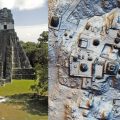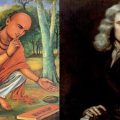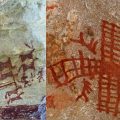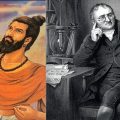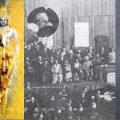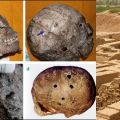Hindus Discovered America 1000s of Years before Columbus? Here is How

The below analysis is an excerpt from Chaman Lal’s book Hindu America.
“Those who first arrived on the continent later to be known as America were groups of men driven by that mighty current that set out from India towards the East “—History of Mexico (Mexican Government Publication).
“The (Maya) human types are like those of India. The irreproachable technique of their reliefs, the sumptuous head dress and ostentatious buildings on high, the system of construction, all speak of India and the Orient— Professor Raman Mena, Curator of the National Museum of Mexico.
“Hindu merchants brought to Mexico the eighteen months year of the Pandavas and the custom of trade guild and Indian bazaar.”—Hewitt—Primitive Traditional History, pp. 83/— 36.
“That the North-American Indians belonged to a Northern race, who made their way to the Southern Hemisphere, both in America and Asia, is proved by the absolute identity between the national system of relationships of the Iroquois (American Indian tribe) and Indian Dravidians, shown in the tables of consanguinity in Morgan’s ‘Ancient Society’ to co exist in the form of marriage which he calls Punuluan (Punya-Lagan in Sanskrit). This I have shown to be a union between alien races, in which the bridegroom received the bride into his clan by making blood-brotherhood with her, and marking the parting of her hair with vermilion, a rite still preserved by all Hindu castes “—Ruling Races of Prehistoric America, p. 234.
One of the most fascinating feature of the ancient civilizations of America is the mystery that shrouds them even in the twentieth century. No other country offers such mysterious problems as the vast continent of America. Innumerable theories, suppositions and surmises have been offered by imaginative brains, and while some of these theories appear reasonable, yet they fail to withstand thorough analysts. Despite the vast amount of research devoted to the ancient civilizations we actually know very little of them. We find ruins of magnificent palaces, splendid temples, great monuments beautiful idols. But there is no written history to prove the origin of the great people who left such wonderful monuments.
The difficulty of sifting the documentary accounts concerning ancient America has long been recognized. Nearly fifty years ago, Adolph Bandeiier wrote: “Not only the history of ancient Mexico, but the true condition and degree of culture of its aboriginal inhabitants, are yet but imperfectly known. Nearly all architectural remains have disappeared; the descendants of the former aborigines have modified their plan of life, and we are almost exclusively reduced, for our knowledge of Mexican antiquities, to the printed and written testimony of those who saw Indian society in Mexico either at the time of, or not long after, its downfall. But these authors, whether eye-witnesses of the conquest, like Cortes, Bernal Diaz, Del Castillo, Andres de Tapia, and others, or missionaries sent to New Spain at an early date, as Toribto of Benavente (Motolinia), Sahagun, or (towards the close of the 1 6th century, or beginning of the 17th century) Acosta, DeviIa, Mendicta and Torquemada, are sometimes, on many questions, in direct opposition to each other. Thus, the uncertainty is still increased, and the most difficult critical labour heaped upon the student. Furthermore, to magnify the task, we are placed in presence of several Indian writers of the 16th and 17th centuries (like Kuran, Texozomoc, and Ixtlilxochitl), who disagree with each other as also with the Spanish authors. It may appear presumptuous, while knowing of the existence of such difficulties, to attempt the description of even a single feature of life of Mexico’s former Indian society”.
Undoubtedly, as Bandeiier says the task is very difficult and a layman like me hesitates to raise his pen on such a mysterious subject. Yet, fortunately, there is enough evidence still left in America itself to encourage me to write on the origins of the ancient people and civilizations in America. ‘When the people of one nation have been conquered and killed by another nation, their property confiscated and the remnant of the people made slaves, and all written records burnt by invaders, nearly everything that is known of them is derived from what has been told by the invaders’. Fortunately, the Spanish historians who accompanied the invaders have left some valuable records of the condition of the people, and their customs and life in the early sixteenth century.
The research into man’s presence in the New World is very interesting and the reader will come across some fantastic theories advanced by various scholars in their zeal to justify their imagination, bus it is not by conjectures and suppositions that we can arrive at a solution of this great mystery. Identity of or at least similarities in facial appearance, food, clothing, religious customs, habits, and above all, similarity in basic philosophy and culture must decide the issue.
Twenty Theories —The obvious impossibility of attributing an autochthonic origin for the Astecs, the last of the ruling races on the North American continent, of which Mexico was the cultural centre, in the face of the evident mixture of races, dialects, languages and religious and social customs in Mexico—all tending to disprove, on the one hand, the racial unity of the ancient Mexican peoples and, on the other, to lend support for theories of succeeding waves of immigration into the country—has led to the propagation of a number of conflicting theories about the immigrant origin of the Mexican people and their ancient civilization. Miss Cora Walker, an American research scholar in this field, sums up in her book Cuatamoc (the last of the Mexican Emperors), no less than twenty different such theories. It is needless to go into all of them in detail, but they may be briefly referred to here.
In Mexico there were white races, a yellow race with almond shaped eyes, brown races, and a black race. The more than thirtyseven different languages, and many more dialects of the country are proofs against the racial unity of the ancient Mexican peoples. Human life in Mexico is believed to be coeval with that of Asia, 10,000 BC or more.
This mixture of races and languages in Mexico, according to one school, is accounted for by immigration into Mexico of people from Atlantis, the Lost Continent, occupying the region now comprised by the Gulf of Mexico, and the Carribean Sea. This continent, it is supposed, got submerged in the ocean as the result of a series of earthquake shocks. In addition, there are four African theories, seven Asiatic theories, and six European theories—all attributing the origin of the ancient Astec civilization to immigrant waves from different countries and of different races in these continents. While these theories are mutually conflicting, yet they unmistakably prove that the Astec culture and civilization are not autochthonous, but have an immigrant origin.
A further reason for accepting this theory is that Mexican traditions themselves claim that their ancestors came from a far and beautiful country. Montezuma, Emperor of Mexico, told the Spaniards that his ancestors came from the far east, across great water and they were white people.
Imprints of India —The theories about European migration to America before Columbus are not supported by research scholars and archaeologists of Mexico. It is quite possible that some people from some of the European countries may have visited America, but there is nothing to prove that any European migration took place to America before the visit of Columbus, whom Europe applauded as the discoverer of America. But the presence of hundreds of thousands of people with Hindu and Mongol features, following Hindu religious customs, worship of Hindu gods Ganesha, Indra and others, the Hindu educational code, system of priesthood, marriage customs, observance of cremation and even Suttee, definitely prove that Hindus and Mongols did migrate to America in large numbers by land and sea. The existence of a sea route between India and Mexico is admitted by many research scholars. According to the Hindu epic, Mahabharata, American rulers participated in the great battle of Kurukshetra and a Hindu prince (Arjun) married Ulupi, the daughter of an American ruler. America was then known as Patala and it was reputed to be very rich in gold. A beautiful description of this unique land is given in the Puranas.
Patala-Home of Gold —According to the Vishnu Purana, the regions below the earth number seven, Atala, Vitala, Nitala, Gabhastimat, Mahatala, Sutala, and Patala. They are embellished with magnificent palaces, in which dwell numerous Danavas, Daityas, Yakshas, and great Snake-gods. The Muni Narada, after his return from those regions to the skies, declared amongst the celestials that Patala was much more delightful than Indra’s heaven. “What, exclaimed the sage, can be compared to Patala, where the Nagas are decorated with brilliant and beautiful and pleasure-shedding jewels? Who will not delight in Patala, where the lovely daughters of the Daityas and Danavas wander about, fascinating even the most austere; where the rays of the sun diffuse light, and no heat, by day; and where the moon shines by night for illumination, not for cold; where the sons of Danu, happy in die enjoyment of delicious viands and strong wines, know not how the time passes? There are beautiful groves and streams and lakes where the lotus blows; and the skies are resonant with die Kiol’s song. Splendid ornaments, fragrant perfumes, rich unguents, the splended music of the flute and pipe and tabor; these and many other enjoyments are the common portion of the Danavas, Daityas, and Snake-gods, who inhabit the regions of Patala.”
Some biased Americans may not have much faith in Hindu records, butAmerican and British authorities can be quoted to prove that the Hindus discovered America thousands of years before Columbus was born.
Wonderful Race from India—Professor Rama Mena, Curator of the National Museum of Mexico, in her book, Mexican Archaeology, says “A deep mystery enfolds the tribes that inhabited the state of Chiapas in the district named Palenque. Their wonderful works of art of perfect design and finished workmanship, seem to say that these people were greatly advanced and of recent age. Yet their writing and the anthropological type, as well as their personal adornments, and finally their systems and style of construction clearly indicate the remotest antiquity. The arrangement of calculliform writing, certain characters and even certain objects vaguely bring to mind the Maya people. But precisely the placing in series of the written blocks, and by the general appearance of the writing it is considered of oriental origin and of greater antiquity than that accorded to the Nestorian Stone, i.e. more than ten thousand years.
“THE HUMAN TYPES ARE LIKE THOSE OF INDIA. THEIR PERFECTION IN DESIGN, THE IRREPROACHABLE TECHNIQUE OF THEIR RELIEFS, THE SUMPTUOUS HEADDRESS AND OSTENTATIOUS BUILDINGS ON HIGH, THE SYSTEM OF CONSTRUCTION, ALL SPEAK OF INDIA AND THE ORIENT.”
Sea Route from India—”The crosses (sacred god tree), birds, also sacred, are eminently Oriental, Buddhistic. Orozco Y Berra has demonstrated this indisputably and AS THERE EXISTS THE POSSIBILITY OF A ROUTE BETWEEN INDIA AND OUR COASTS, WE ARE VERY NEAR SOLVING THE MYSTERY THAT ENFOLDS THIS RACE.”
Hindu Origin of languages—The same author writes: “At present we are studying the native tongues and find that at least as far as Nahuatl, Zapotcca, and Maya languages arc concerned they are of Hindu-European (Sanskrit) origin. The aforementioned studies are by Dr. Magana Peon and Professor Humberlo J. Comvn, both members of the Geographical Society of Mexico.”
Ten Thousand Year Old Civilization—The Mexican Professor concludes: “In Palenque, we find what is probably the oldest civilization in America. At least ten thousand years old, yet its calculliform writing is wonderful, though not legible in all its parts, for as yet we have deciphered only certain dates, Oriental phonograms and signs which are isolated without connection. This is all we have been able to read of the venerable writing in square figures found in bas relief on stones and earthen vessels.”
Hindus Reached America first — And this is what the oriental historian of the Mexican Government says in General Outline of the History of Mexico:— “What is called tbc discovery of America is the meeting of two great currents of races of people, who, after a separation extending over many centuries, were again joined after going right round the earth.
“Humanity, which originated in Asia, was scattered by movements of expansion, on the one side towards the west (Asia Minor, Egypt, etc.) to create there western culture, Graeco-Latin or European, and on the other towards the east, to India, China, Japan and the Islands of South Seas. AND THOSE WHO FIRST ARRIVED ON THE CONTINENT, LATER TO BE KNOWN AS AMERICA WERE GROUPS OF MEN DRIVEN BY THAT MIGHTY CURRENT THAT SET OUT FROM INDIA TOWARDS THE EAST.”
Hindus as World Traders—The Mexican historian’s theory about trade route between India and Mexico is supported by Hewitt, a renowned research scholar. He says: “It was only in an age of peace, when the kings and their principal advisers were merchants like Anatha Pindika, the trading Prime Minister of the King of Sravasti in Buddhist history, and the Khewat fisherman kings of Tamralepti in south west Bengal in the Bronze Age, that the commerce of the Turvasu Yadavas, sons of the date palm-tree, with China, the Malacca Peninsula, and the islands of the Malaya Archipelago in the east, and with Persia, Egypt, North Africa, Syria, Asia Minor, Greece and Italy in the west, could be maintained.”
Hindu Merchants in Mexico—Hewitt proves how Hindu merchants introduced the Hindu bazaar system in Mexico. He writes : “This commerce and the emigration accompanying it extruded to China and also to the southern islands of Polynesia and Melanesia, and, as we shall now see, emigrant tribes instructed in its creeds and imbued with traditional Indian beliefs brought to Mexico the eighteen months year of the Indian Pandavas, the worship of the Indian elephant cloud – god Ganesha, the ritual of the Antelope worshippers of the corn-god represented in Mexico and North America by the maize sheaf, the reproduction of the rice sheaf of the Malayns of Eastern Asia and India, and of the barley-god of India, South-western Asia, and Europe; also the Naga snake and antelope dances which were introduced into Mexico in forms as ancient as the oldest survivals in India of the popular worship of the antelope-god Krishna and the Naga snakes of the Naga Kushika era, who appear so prominently in Buddhist sculptures and the Jataka birth-stories. The Mexican founders of the state of society in which the eighteen-months year was made the official measure of time were the trading and artisan Toltecs, whose name Toltecatl, originally meaning the dwellers in the land of reeds (tollan), came to mean skilled artisans. Among them, as among the Kushikas, each trade had its own guild, to which a special quarter of the city was assigned as in Indian bazaars. Each guild was ruled by its own tutelar deities of the festivals held in accordance with the guild ritual. The profession of artisan was looked on as most honourable, and as in the South-western Asia portrayed in the Arabian Nights and in Buddhist India, the merchants held the highest rank in the State.”
This article is an exact excerpt from the book Hindu America by Chaman Lal, published by New Book Co, Hornby Road Bombay in 1940.
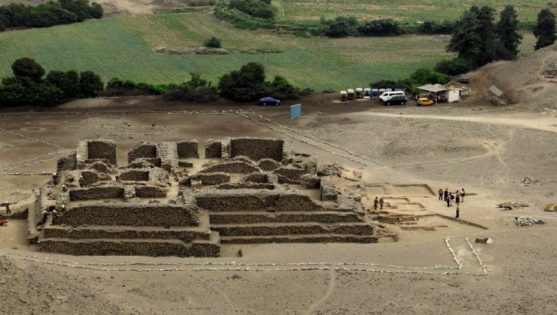
Vedic Havan Kund Peru; Image source: booksfact.com
A huge 5000 plus years old Vedic Havan Kund was discovered few years back at El Paraiso in Peru in the Americas. According to radiocarbon analysis, the site dates back to at least 3000 BCE. This site is named Temple of Fire (Temple of Agni), which is actually a huge Havan Kund. The walls, in four levels, have coatings in yellow clay besides traces of red paint. The entrance measures around 48 centimeters wide and the Kund is 26 by 20 feet. This is one of the oldest monuments discovered in America.
Likewise, a number of more archaeological finds in America prove that ancient Sanatanis migrated from India and settled here and in more places across the world. Besides, idols of Hindu deities were discovered in Germany, Iran, Egypt, and other parts worldwide.
Featured image courtesy: Hindu America by Chaman Lal.
Team MyIndiaMyglory
Latest posts by Team MyIndiaMyglory (see all)
- BAIC Exhibition: Confluence of Interiors, Architecture, and Construction Industry - October 23, 2024
- Temple Treasures: Evolution of Temples from Ancient to Present - October 23, 2024
- Akal Bodhan: Ram’s Invocation of Durga during War against Ravan - October 23, 2024

